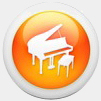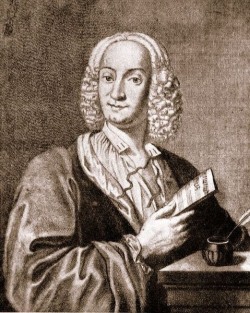
|
|
| HOME LESSONS CHILDREN'S SONGS COMPOSERS |

PIANO LESSONS  CHILDREN'S SONGS 
COMPOSER LESSONS |
Antonio Vivaldi—a music appreciation lesson for kidsBiography
 Antonio Vivaldi (1678 to 1741) was born and lived in Italy, and was a BAROQUE style composer and violinist. Vivaldi had very bright red hair and was nicknamed "the Red Priest." His dad, Giovanni, was a barber before becoming a professional violinist. He taught his son probably at a very young age to play violin. As an adult, Vivaldi became a Catholic priest. However, his asthma kept him from saying the mass. He then went to teach in an orphanage for girls, and composed lots of music for them; for example Vivaldi wrote over 400 concertos for his students. While Vivaldi's music was quite popular in his lifetime, towards his final years his music fell out of popularity, and he died as a pauper. Listen to Vivaldi's The Four Seasons!The most well-known piece of music he wrote was a set of violin concertos titled "The Four Seasons." The concertos are accompanied by sonnetes (poems) that depict the seasons. Some people think that Vivaldi wrote the sonnets himself. For each season, there are three parts. The parts are titled with Italian words such as Allegro (joyfully) or Largo (slowly). These Italian words indicate the TEMPO of the piece—how fast or slow it should be played. Read the poem that goes with each part of The Four Seasons, and then listen to the part. Does the music resemble or portray the things in the sonnets? Does the music match the seasons? You can also draw on paper what the music makes you "see" in your mind. Compare your thoughts and feelings with those around you. In the audio files below for the Four Seasons, John Harrison plays the lead violin. I don't have information about the other musicians. Licensed by CC BY-SA 3.0. Spring1. Allegro (fast, joyfully)
Springtime is upon us. Children: Can you hear the joy of spring and the birds? Can you then hear the thunderstorm? And can you lastly hear the birds again? 2. Largo (slowly)
On the flower-strewn meadow, with leafy branches rustling overhead, the goat-herder sleeps, his faithful dog beside him. Children: Does the music sound restful, like someone is sleeping? 3. Allegro (fast, joyfully)
Led by the festive sound of rustic bagpipes, nymphs and shepherds lightly dance beneath the brilliant canopy of spring. Children: In this music, we first hear bagpipes. Later on, there are musical passages as if someone is dancing. Summer1. Allegro non molto (not very quickly)
Under a hard Season, fired up by the Sun Children: This piece starts out slow, as if animals and people are "languishing" in the unpleasant, hot sun. In the middle the music is a bit faster: there is the soft breeze. The loudest part is like the threatening north wind. Later on, the violin plays alone, singing like birds. Then suddenly the music sounds fearful: the shepherd trembles. Can you hear all that? 2. Adagio e piano - Presto e forte (slow at ease and soft - very fast and loud)
The fear of lightning and fierce thunder Children: Does the music sound like someone is resting, but occasionally feels fearful? 3. Presto (very fast)
Alas, his fears were justified Children: Does the music sound like thunder and lightning? Autumn1. Allegro (fast and joyfully)
Celebrates the peasant, with songs and dances, Children: This music starts out joyful and very happy, because the farmers are celebrating the harvest with songs and dances. Can you hear the parts where a few of them get tired and fall asleep (music slows down)? 2. Adagio molto (very slow)
Each one renounces dance and song, Children: Can you hear how this music sounds like "sweet slumber" (deep sleep)? 3. Allegro (fast and joyful)
The hunters emerge at the new dawn, Children: The music starts out march-like, when the hunters and dogs and horns are going boldly to hunt. When you hear the violin playing solo (alone), it portrays the beast that is fleeing and being hunted. Winter1. Allegro non molto (not very quickly)
To tremble from cold in the icy snow, Children: In the beginning, the music sounds like trembling because of the cold. The parts where the violin plays solo, it's like someone running and stamping their feet to keep warm. Does any part of the music sound like chattering teeth? 2. Largo (very slowly)
We move to the fire and contented peace, Children: When you listen, can you imagine staying warm and peaceful in front of the fireplace? 3. Allegro (fast & joyful)
We tread the icy path slowly and cautiously, for fear of tripping and falling. Children: The music starts out carefully, cautiously, and not very fast, like treading on ice. Can you hear it getting faster—someone hastening and hurrying? Near the end we hear the north wind and its chill... Here's also one video, an excerpt from Antonio Vivaldi's famous Concerto for 2 Cellos, Strings & Continuo in G minor. It is performed by New Trinity Baroque orchestra (on instruments similar to those used in Vivaldi's time), and directed from the harpsichord by Predrag Gosta.
I hope you liked the song/lesson!I'd also like to introduce you to my favorite: 24K Gold Music - dynamic musical showband performing many genres and styles of music! Check out my monthly GIVEAWAY RAFFLE for 24K Gold Music CDs!
|
